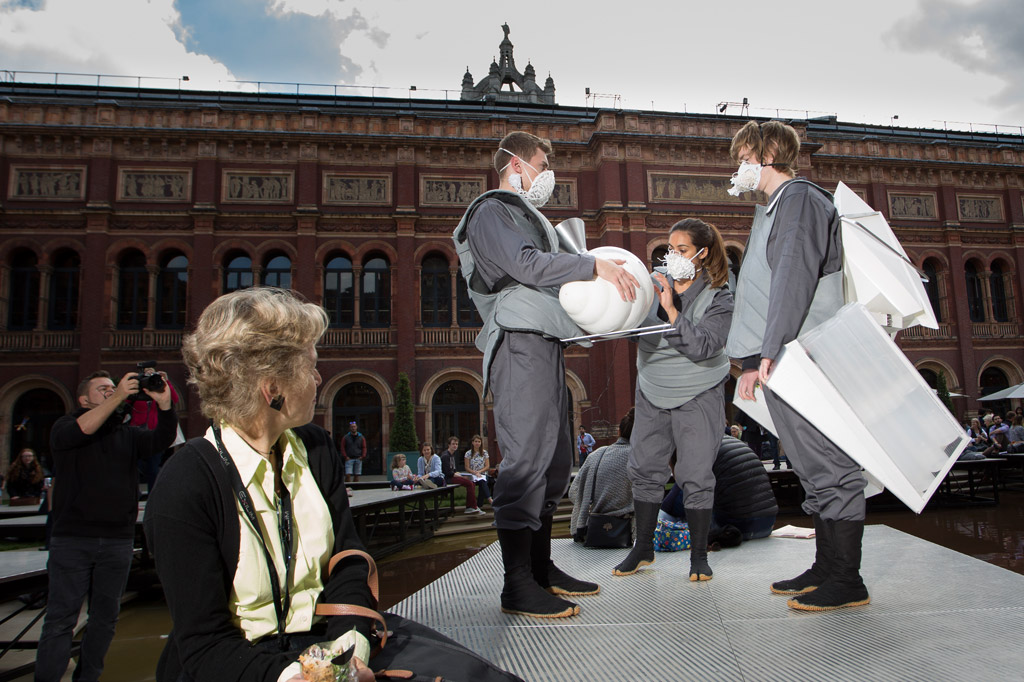Science and art – the rules of engagement
Public engagement is a big buzz word in academia right now, and researchers are increasingly on the lookout for new ways to engage people in their research and spark debate.
I was recently appointed in a new role for a Loughborough University-based project to help scientists do just that, but even I didn’t expect that my first weekend in post would be spent at the V & A museum in London, watching a surreal art performance called “Instruments of the Afterlife”.
I work for an EPSRC-funded enabler project called Creative Outreach for Resource Efficiency (CORE) and its aim is to help a network of EPSRC-funded resource efficiency projects (CL4W, CLEVER and EXHUME) deliver high-impact science, while also ensuring the academics ‘get out of the lab’, provoke public debate and deliver public engagement activities.
Instruments of the Afterlife was the result of collaboration between scientists from the Cleaning Land for Wealth (CL4W) project and art-duo, Burton Nitta. CL4W (pronounced claw) explores ways in which contaminated land can be brought back to life using plants to collect toxic metals and how these plants can then be processed by bacteria to form useful metal nanoparticles.
The CL4W team – supported by CORE – was interested in ways they could engage others in their work, using innovative and inspirational methods. They chose to explore working with artists to find new ways of communicating and to reach new audiences.
Dr Louise Horsfall from Edinburgh University led the engagement project, supported by Dr Phil Longhurst from Cranfield University. They first met Burton Nitta at a mini-science fair held at Loughborough University where the art-duo worked with local school children, using art as a mechanism of engagement.
Dr Longhurst was struck by how the children engaged with an art piece called Algae Mask, and concluded that impact is about getting that connection, then getting the facts across once the interest is there.
This revelation – that gaining impact is about getting a connection with the audience and not focusing on scientific details, underpinned the scientists’ approach to working with the artists.
Although the artists were given a brief, it was deliberately broad, so they could have the freedom to interpret the brief as they saw fit.
“When I heard the title, ‘Instruments of the Afterlife’, I thought it was fantastic and terrifying in equal measure. But brilliant as well; we asked for a surprise and we got what we asked for. It felt exciting and risky – which is what CORE is all about.”
BurtonNitta visited each university within the CL4W group (Edinburgh, Cranfield, Warwick, Newcastle and Birmingham) interviewing the biologists, scientists and engineers, taking photographs of them at work and filming them.
They then produced diagrams and artwork that communicated what the project was about, showing the relationships between the engineering processes and the synthetic biology as well as the desired results – cleaning land that is currently contaminated and gaining valuable materials from the process.
From this a performance was devised, taking the interpretation of the science to a different level, and taking the audience into a future world where we are dependent on reclaimed materials as earth’s resources are depleted. This leap of the imagination engaged the audience in a world that is not yet real, yet could still come to pass.
For scientists, accustomed to precision and exactitude in their work, this approach was as exciting as it was unusual, and helped them reach out to new audiences and far exceeded their initial ambitions.
So what would be my advice to others thinking of working with artists to widen engagement in their work?
- Develop a brief that identifies the outcomes you want, but not the path to getting there.
- Be prepared to answer questions, and to express your work in language that is understandable to a non-scientist.
- Be available and involved in the process, without controlling it.
- Find out as much as you can about the artists you want to work with – are they easy to work with, are they listening to what you have to say?
- Identify your audiences – who do you want to engage with?
Identify your criteria for success, but be prepared for this to be redefined by the process and outcomes.
About CORE
CORE is funded by EPSRC and is working with three multidisciplinary projects investigating different aspects of resource efficiency. CORE is facilitating creative outreach between these projects with a range of audiences. Two schools from Loughborough University are involved in the CORE Project – the School of Civil and Building Engineering and Loughborough Design School.
Find out more about the CORE network
Amanda Miller is CORE Knowledge Exchange Manager at Loughborough University

